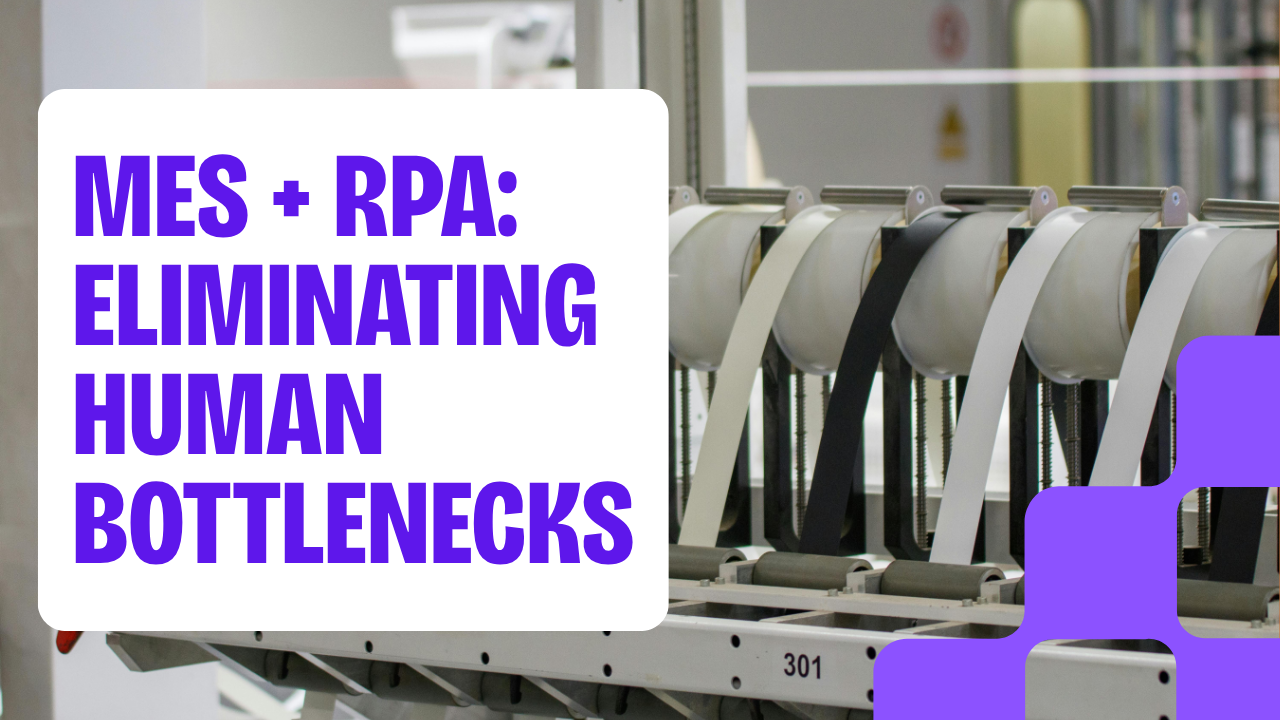Manufacturers today face increasing competitive pressure – to deliver faster, operate leaner, and maintain high-quality standards. The demand for greater agility, efficiency, and visibility across production lines is pushing many companies toward digital transformation.
Manufacturing Execution Systems (MES) and Robotic Process Automation (RPA) stand out as key enablers in this change. While MES gives manufacturers real-time control over shop-floor operations, RPA automates repetitive, rule-based digital processes that connect production with business systems. When integrated, these two technologies create a seamless bridge between physical production and digital workflows, enabling a truly automated, data-driven factory.
What is MES and Its Benefits
A Manufacturing Execution System (MES) is software designed to monitor, control, and manage all manufacturing activities on the shop floor. It acts as the operational layer between an organization’s ERP system (which plans production) and the actual execution on machines, lines, and equipment.
MES plays a central role in connecting data from operators, machines, sensors, and quality systems to provide real-time visibility into production. Its main functions include:
- Production and order management: tracking the status of each order as it moves through the factory.
- Resource and material management: ensuring machines, materials, and personnel are efficiently allocated.
- Quality and traceability: collecting data to verify that production meets quality standards and compliance requirements.
- Performance monitoring: measuring OEE (Overall Equipment Effectiveness) to identify bottlenecks and improve productivity.
It provides real-time visibility into every production step, helping managers identify issues before they escalate. It improves operational efficiency by optimizing scheduling, reducing idle time, and minimizing waste. It strengthens quality control and ensures traceability across materials and processes – a critical requirement in regulated industries. Finally, MES helps reduce production cycle times by aligning planning with real-time shop-floor execution.
By implementing MES, manufacturers move closer to smart, data-driven production where decisions are based on accurate, live data rather than manual reports.
What is RPA and Its Benefits
Robotic Process Automation (RPA) is a software technology that uses digital “bots” to perform repetitive, rule-based tasks traditionally handled by humans. In manufacturing, RPA is not about physical robots but about automating the flow of information across digital systems such as MES, ERP, and quality management platforms.
RPA bots can be programmed to mimic human actions – logging into applications, copying and entering data, creating reports, sending notifications, or integrating information from multiple systems.
In a manufacturing context, RPA can:
- Automate data entry from MES into ERP systems or production dashboards.
- Generate daily or shift reports automatically, using real-time data from MES.
- Validate and synchronize data across systems, ensuring consistency.
- Handle inventory updates, production logs, and quality records without manual intervention.
It boosts productivity by freeing employees from repetitive administrative tasks, allowing them to focus on higher-value work. It reduces human errors and improves data accuracy across systems. With bots operating 24/7, they shorten process cycles and speed up communication between departments.
Why Combine MES and RPA
MES and RPA address different but complementary aspects of automation. MES controls and monitors what happens on the shop floor; RPA connects that data to the broader ecosystem of business systems and decision-making processes.
When integrated, MES and RPA form a closed loop of operational automation – where production data flows smoothly, actions are triggered automatically, and decisions are made faster.
1. Seamless Data Synchronization
RPA automatically transfers information between MES, ERP, and other enterprise systems. For example, when MES records production completion, RPA can update ERP with inventory data, generate shipment requests, and trigger financial entries – all without human input.
This synchronization eliminates data silos and ensures that every department operates with the same, up-to-date information.
2. Faster Decision-Making
By processing MES data in real time, RPA enables instant insights for production managers and executives. Reports and dashboards that once took hours to prepare can now be generated within seconds.
This visibility empowers faster, data-driven decisions on production adjustments, maintenance schedules, or resource allocation.
3. Error Reduction
Manual data entry between MES, ERP, and other systems often leads to errors or delays. With RPA, data movement is automated and standardized. The result is fewer mistakes, more accurate records, and smoother communication across systems.
4. Resource Optimization
MES ensures optimal scheduling and resource utilization within the factory. RPA enhances this by automating surrounding workflows, such as material requests, inventory updates, and performance reporting.
Together, they ensure that both production and administrative processes are synchronized for maximum efficiency.
5. Agility and Scalability
The combination of MES and RPA allows manufacturers to scale automation as their operations grow. New processes can be automated quickly without disrupting existing systems. This flexibility supports continuous improvement and aligns with the principles of Industry 4.0, where agility and integration are key competitive advantages.
WinActor RPA Integration with MES
WinActor RPA offers a powerful solution by automating these interactions: it can extract data from MES, post production updates, generate reports, and synchronize inventory – all without human intervention. With high precision and uninterrupted operation, WinActor turns MES data into actionable insights, boosting productivity, cutting operating costs, and elevating your factory toward true smart manufacturing. Want to see WinActor + MES in action? Get in touch with us for a live demo and expert consultation.





